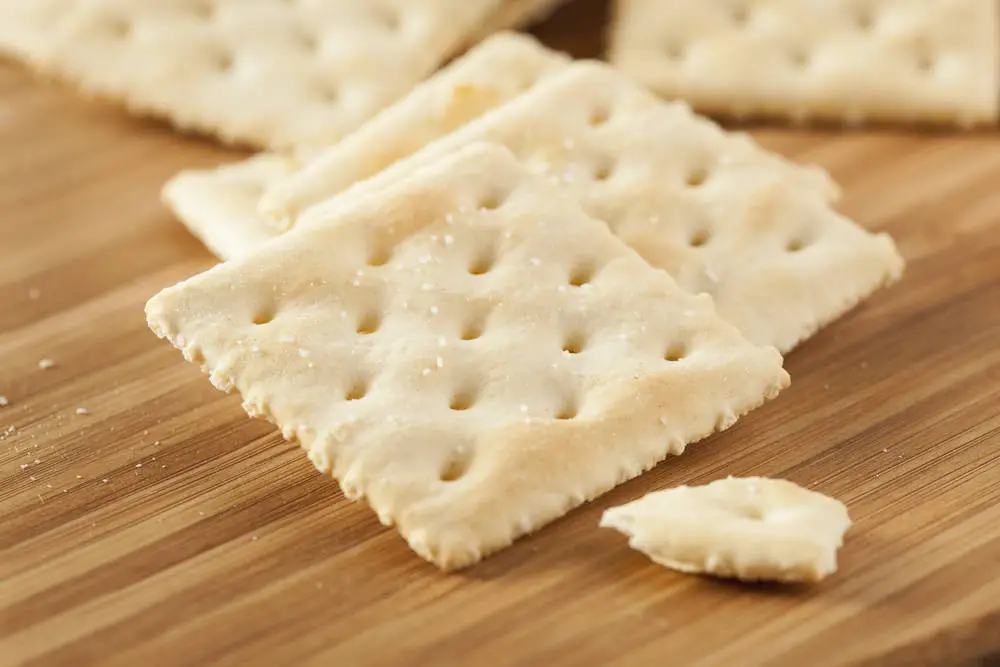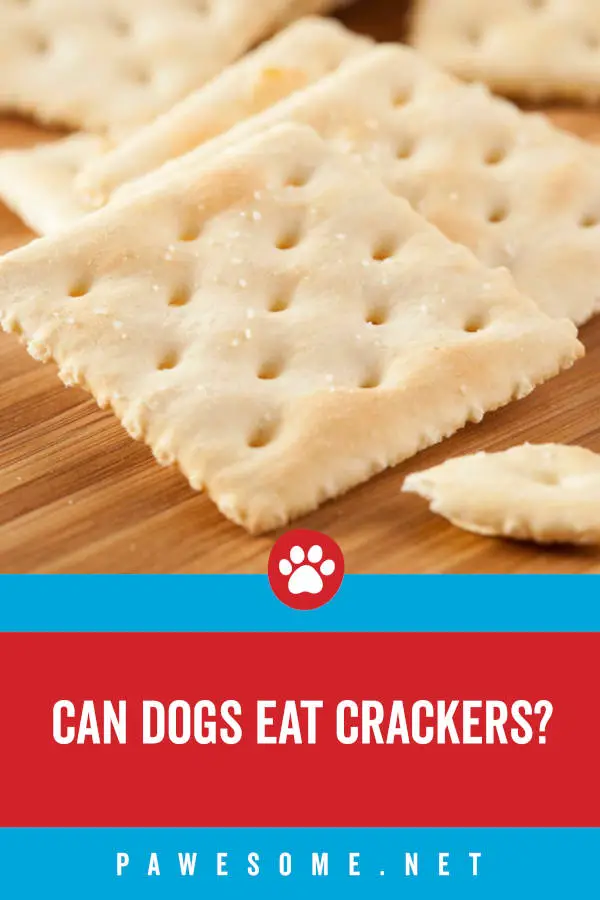
Crackers are a popular snack that you are bound to find in every household. It wouldn’t be surprising if you love to bake some yourself. When you pass this tasty, salty and sweet snack around the table, you may also be generously sharing it with your pooch with the melting eyes. When she looks at you like that, how can you be heartless and resist! And if it’s just the two of you, sharing a few tidbits with this seemingly harmless snack may seem natural.
Dogs are known to smell a good thing from far and the moment you start eating, they tend to hang around you with such a hangdog expression that it is hard to resist or ignore. You may also be using the crackers as a treat to train your dog in good behavior. This can get them used to the taste and expect to be given a morsel everytime you are having it.
It’s not just you. This is how it has been for centuries. This begging-feeding behavior has its roots tracing back 33,000 years ago when dogs were domesticated. The two of you are simply following the instincts shared by dogs and their parents ever since then!
A Walk Back in Time
The dog has evolved from a subspecies of the grey wolf called Canis lupus familiaris and is classified as a carnivore. This is also borne out by the fact that they have carnivorous traits such as sharp teeth and a meat drive, but the truth is that they are omnivores, and have probably become so because of their domestication.
They are used to the scrappage from the table and their digestive systems can handle plant-based foods as well. Grains are one of the things they can digest and cooked food as well, unlike their wolf ancestors.
So you may enjoy sharing with them everything you eat, including the crackers. Because you do not see them react in any negative way right away, you may think everything is well in the pet world. You could be right. We hope you are right. But we dread to suggest that troubles could be building up to erupt one day sometime in the future.
Crackers Recipe
No, we are not going to really start sharing recipes here but just want to run you through the ingredients and the method of making crackers to help you understand how they can impact the health of your pet.
Crackers are made using all-purpose flour or a mix of all-purpose and whole grain flours; sugar; salt and olive oil. Then there are the toppings, depending on how you like it.
Now, flours are made of grains and studies suggest that grains are good for your pooch. In fact, normally, pet food is overloaded with protein, which can harm the kidney. It can cause azotemia or uremia due to increasing the levels of nitrogen compounds in the blood. The kidney loses its ability to remove wastes from the blood, putting pressure on the kidneys and, finally, permanent kidney damage.
In such a scenario, food with some grains can only help the pet. So, yes, you can share this crunchy and yummy treat with your loyal friend. However, here it is not just about the grains. It has other ingredients too that can be harmful for your companion.
Related: Can Dogs Eat Okra?
Sodium – Enemy No. 1
Crackers come with a high salt content, which is one of the reasons they are so delectable, of course. You know, don’t you, that too much salt is not good for you? For the pet, it can be worse.
Just as a high intake of salt is associated with the development of hypertension, renal failure and coronary heart disease in humans, it is equally bad for the dogs too.
With processed pet food already containing salt, they don’t need anything additional.
In fact, sodium is the tenth most abundant element in the body at just less than 0.2% of a dog’s bodyweight. It has a role to play in the maintenance of
osmotic pressure and extracellular volume, acid-base balance and conductivity in neural tissues along with chloride.
Dogs also get all the sodium they need from dietary sources such as meat and dairy products. Pet foods come with salt or sodium chloride for adding chloride. For texture, pet food manufacturers add sodium tripolyphosphate and add sodium nitrite to preserve color.
The canine intestinal tract can absorb more than 95% of dietary sodium and excessive sodium can cause vomiting, increased plasma volume, increased excretion of potassium leading to a negative potassium balance.
The good news is that healthy dogs are tolerant to high salt up to a point and can handle sodium fluctuations. So you don’t have to worry that a little bit of that snack is going to see him curling up and giving up his ghost.
But salt is not something they crave. This study also suggests that they cannot taste it. So, you can just give a tidbit as a treat but not overdo it.
Starch: Enemy No. 2
Saltine or soda crackers, though thin and low in calories, they are also low in nutrition value. There is absolutely negligible vitamin and mineral content in that thin piece of snack.
However, you would be surprised at how high it is on starch. A serving of five standard saltine crackers weighing 15 grams contains as much 11 grams or 67.8% of starch.
In 2018, the Association for Pet Obesity Prevention conducted a survey and found that at least 56% of the dogs in the United States were overweight or obese. With fat food being free easily available, the reason for this continued gain in weight is attributed to carbohydrates, which is already abundantly found in pet foods.
Modern pet foods undergo a process called extrusion which allows for mass production of food. However, this results in a high starch content in pet foods. Naturally available food does not contain much starch and it is not needed by the body either.
Dogs need protein and fat but not starch. So much starch affects the insulin activity. Insulin has other functions besides moving sugar, or glucose, out of the blood. It converts glucose into fat and stores it in the body. When it is activated, it prevents the body from breaking down and mobilizing fat stores. So when dogs are given foods with high insulin, they will start becoming fat even if they are having a low-calorie diet.
The sugar in the cracker can get your pooch, which has a sweet tooth just like you, hooked to the crackers and slowly build up the glucose level in the blood too. This is too much for the insulin to handle and you are soon going to see your pet struggle with his or her weight.
Related: Can Dogs Eat Sunflower Seeds?
Beware of Toppings
The fun things about crackers are the toppings and the dips. Most dips such as guacamole, hummus or ranch are usually spicy and have onion and garlic. These too are harmful to a dog’s health.
Whether dehydrated, raw or cooked, onion and garlic can cause severe poisoning, leading to breathing problems, vomiting and weakness. They can cause anemia by killing red blood cells.
Spices are another thing best avoided when feeding your pet crackers. An upset stomach upset is a common reaction.
Even dairy products such as cheese and butter can prove harmful for your innocent pet as they may be lactose intolerant. This too can cause allergies and gastrointestinal distress.
To Give or Not
Go on, give one as a reward for good behavior. Maybe a half piece more because she was exceptional. And then stop.
Eating crackers in moderation is not going to make your pooch overweight or sick. Provided, you are feeding your loyal friend a nutritious meal at all times. They must get the right nutrients from their meals to keep their shine and rigor.
Snacking, like in human beings, can be fun but detrimental to your pet’s health. The cracker has starch, sugar and salt—the three S’s that can prove to be harmful in the long run. Your pooch will definitely stop being active and lively over a period of time due to becoming overweight or obese.
High sugar also creates similar problems in dogs as in humans and is best avoided. While salt in itself is not harmful, excessive intake can disrupt the health of your pet. Toppings and dips can really take the cake, causing anything from anemia to poisoning.
So treat it like a reward and make it a really special treat. Not having crackers is not going to impact the health of your pet. Having too much is.
Finally
Love is a dual-edged sword. When those soft brown eyes look at you with so much expectation and trust, you cannot but give in. You want to share your joys and snacks with your companion.
But this same love and sharing should not become a burden for your little one. The dog trusts you with his life. You must preserve that trust by giving him the right kind of food that keeps him healthy and active. Keep the crackers for an odd day.


